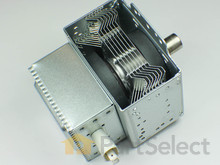Appliance Parts
- Accessories
- Dishwasher
- Dryer
- Stove / Oven
- Microwave
- Refrigerator
- Washer
- See more... See less...
Lawn Equipment Parts
- Lawn Mower
- Chainsaw
- Blower
- Generator
- Air Compressor
- Lawn Tractor
- Pressure Washer
- See more... See less...
How to Fix a Noisy Microwave

Click a Part Below to Start Your Repair:
Drive Motor Magnetron Drive Coupler Roller Guide High Voltage Diode Cooling FanAbout this repair:
- Rated as REALLY EASY
- 6 repair stories
Drive Motor
If an unusual noise is coming from your microwave turntable, the issue may be the drive motor. The microwave uses a motor-driven coupler to turn the glass tray in your microwave. The motor should be replaced if it is making a grinding noise.
How to test a microwave drive motor with a multimeter:
- Unplug your microwave before beginning.
- In order to access the drive motor, you will need to remove the appliance’s cabinet. The motor is usually located in the bottom of the microwave and is held in place by a retaining screw and wires.
- Remove the motor to test it for continuity. Set your multimeter to the highest setting and touch the probes to the terminals. A properly functioning motor will produce a reading of zero.
- If your microwave makes a grinding noise, or if the motor does not have continuity, then you may need a replacement drive motor.
Magnetron
If your microwave is making a loud humming or buzzing noise, it may mean the magnetron is not working properly. The magnetron is part of the high voltage circuit that generates heat in the microwave.
How to test microwave magnetron with a multimeter:
- Begin by unplugging your microwave; you will be handling electrical components.
- Remove your microwave’s cabinet and locate the magnetron. Before inspecting the magnetron, discharge the high voltage capacitor. Verify that the mounting bolts are tight and that the high voltage diode is working. If no issues are found, remove the magnetron in order to test it.
- Test the magnetron for continuity. To do this, set your multimeter to Rx1, touch one probe to a terminal and the other to the metal housing of the magnetron, this test should indicate that there isn’t continuity. Next, touch both probes to the terminals, this should produce a reading of two to three ohms.
- If your test results differ from the above, you will need a replacement magnetron.
Drive Coupler
An unusual noise coming from your microwave may mean there is a problem with the drive coupler, which helps power the glass turning tray.
How to inspect a microwave drive coupler:
- Unplug your microwave before beginning this inspection.
- Open the microwave door and remove the tray and roller guide to inspect the coupler. On some models, you may need to remove the motor from the floor of the microwave before inspecting the coupler.
- Remove the drive coupler to inspect it closely. You are looking for any signs of wear, discoloration, or cracks.
- If you find any of the symptoms above during your inspection, you will need a replacement drive coupler.
Roller Guide
If an unusual noise is coming from the turning tray in your microwave, the issue could be with the roller guide, which helps the turning tray to rotate without friction.
How to inspect a microwave roller guide:
- This is a very simple inspection; no tools or disassembly are required.
- Open your microwave door and remove the glass tray.
- Visually inspect the roller guide, for any signs of damage, discoloration, cracking, or wear. Verify that all the wheels rotate freely without resistance.
- If you find any of the issues listed above, you will need a replacement roller guide.
High Voltage Diode
If your microwave is making an unusual noise that sounds like loud humming, the high voltage diode may be the problem. This part works with the capacitor and magnetron to heat the microwave.
How to test a microwave high voltage diode with a multimeter.
- Before beginning this or any other microwave inspection, verify that you have disconnected your appliance from the power supply.
- You will need to remove the high voltage diode in order to test it for continuity. Begin by removing the cabinet and discharging the high voltage capacitor to avoid getting an electrical shock, then remove the diode from your appliance.
- Using a multimeter set to Rx1, touch the probes to the terminals, and then check for continuity in the opposite direction by reversing the probes. There should be continuity in one direction, but not both.
- If your diode shows continuity in both directions or does not show continuity in either direction, you will need a replacement high voltage diode.
Cooling Fan
An unusual noise when your microwave is on may be coming from the cooling fan. The cooling fan cools the magnetron while the microwave is in use.
How to inspect a microwave cooling fan:
- To ensure your safety, begin by unplugging your microwave.
- The cooling fan will be located inside the cabinet; you will need to remove the cabinet and the fan assembly cover in order to access it.
- Once you have located it, inspect the fan assembly for any signs of wear or damage to the blades. You should also look for and remove any objects or debris that the blades might be coming in contact with and causing the noise.
- If you find that your fan is worn, discolored, or damaged, you will need a replacement cooling fan.
More Repair Parts
Still not sure which part is broken? We can offer you custom troubleshooting help if you search with your model number.



















































